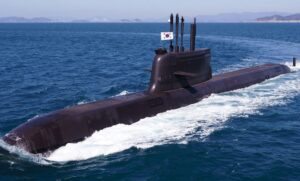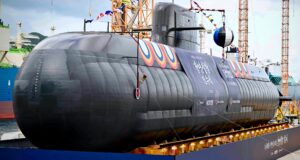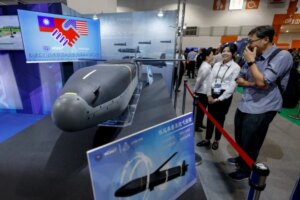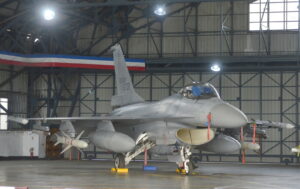新M-346N教练机助力美军飞行员掌握F-35C操作技巧

快速阅读: 2025年12月前,美国海军计划发布UJTS项目招标书,Textron和Leonardo联合提出M-346N方案,以替代T-45 Goshawk,适应新型训练需求,减少对航母的依赖,提高飞行员培训效率。
The proposal follows the release of multiple Requests for Information (RFIs) by the Navy in recent years and anticipates a Request for Proposals (RFP) by December 2025. The M-346N has been introduced in response to the planned retirement of the T-45 Goshawk and is designed to align with the Navy’s updated requirements for undergraduate jet training, including a shift away from arrested carrier landings. Textron and Leonardo have established a teaming agreement for this program and are advancing preliminary engineering work to adapt the M-346N to U.S. Navy-specific systems.
The M-346N is proposed without carrier landing capability, in line with the Navy’s revised training objectives. The fifth RFI indicates that the new aircraft will only need to perform Field Carrier Landing Practice (FCLP) to wave-off, eliminating the requirement for structural reinforcements such as a tail hook or launch bar. This adjustment simplifies the aircraft design and focuses the program on ground-based training complemented by simulation. The M-346N is based on a platform currently in use with the air forces of Italy, Israel, Singapore, Poland, Greece, Qatar, Turkmenistan, and more recently ordered by Austria and Nigeria. Its training system includes a Live-Virtual-Constructive (LVC) architecture, adaptive training features using AI, and full-spectrum ground-based training tools. Textron has also indicated that initial pilot instruction could be conducted at the International Flight Training School (IFTS) in Italy while U.S. infrastructure is being prepared.
The aircraft features two Honeywell F124-GA-200 turbofan engines, fly-by-wire flight controls with quadruple redundancy, and a cockpit equipped with Large Area Displays (LADs), Head-Up Displays (HUDs), Hands-On Throttle and Stick (HOTAS), and Helmet Mounted Displays (HMDs) with integrated Augmented Reality. The M-346N is capable of speeds exceeding Mach 1.2 and has a service ceiling of 45,000 feet. Its Embedded Tactical Training System allows for simulation of radar, weapons, and threats, while the onboard Pilot Activated Attitude Recovery System and Automatic Ground Collision Avoidance System are integrated for safety. The training ecosystem includes high-fidelity simulators, mission planning tools, a real-time monitoring station, debriefing systems, and virtual maintenance trainers. The LVC framework enables real-time interaction between aircraft, simulators, and computer-generated forces to emulate tactical environments without live weapons or munitions.
The Navy’s approach to pilot training has evolved based on three primary considerations: training time, cost of high-end aircraft use, and increased cockpit complexity. According to Leonardo U.S. official David Kindley, the goal is to accelerate pilot readiness while moving expensive training previously performed on F-35Cs or F/A-18 Block III aircraft into earlier training phases using less costly systems. The Navy also seeks to incorporate mission system management and data processing into the curriculum, reflecting the operational demands of modern combat aircraft. Field Carrier Landing Practices remain in the syllabus, but the Navy will no longer require arrested landings, citing the introduction of Precision Landing Mode (PLM), which reduces the number of pilot corrections during final approach. PLM standardizes aircraft descent profiles, thereby reducing structural fatigue and minimizing training variations. This change reduces dependency on aircraft carriers for early-stage pilot training and increases reliance on simulators and digitally enhanced training methods.
The UJTS program emerged as the planned replacement for the T-45 Goshawk. After issuing its first RFI in 2023, the Navy updated program requirements multiple times through 2024 and 2025. The current acquisition strategy includes ordering 10 aircraft in FY2026, 12 in 2027, another 12 in 2028, and 25 annually starting in 2030 for full-rate production. The program aims to procure at least 145 aircraft. In addition to the M-346N, the Boeing–Saab T-7A Red Hawk and the Lockheed Martin–KAI T-50 are also competing. Textron had previously offered the T-100, based on an earlier M-346 configuration, for the U.S. Air Force T-X competition but was not selected. Despite this, Textron has supported the Navy with training aircraft for over 70 years. Assembly of the M-346N could begin at Leonardo’s facility in Venegono, Italy, though the companies are evaluating a U.S.-based final assembly site. Italy qualifies under the Buy American Act, which allows initial foreign production; the Act’s domestic content threshold is increasing from 60% to 75%.
The Beechcraft M-346N has a length of approximately 11.5 meters and a wingspan of 9.72 meters. Its empty weight is around 4,600 kilograms, with a maximum takeoff weight near 9,500 kilograms. It is powered by two Honeywell F124-GA-200 turbofan engines and designed to operate in transonic flight regimes without afterburners. The aircraft is capable of a climb rate exceeding 6,000 feet per minute and can withstand sustained load factors up to +8G. The M-346N is equipped with an internal fuel system that supports an unrefueled range exceeding 1,000 kilometers and can be fitted with external drop tanks to extend its operational endurance. The aircraft is certified for both Visual Flight Rules (VFR) and Instrument Flight Rules (IFR), allowing it to conduct missions in both clear and reduced visibility environments. Its onboard systems include an air data and inertial navigation suite, dual civil and military communications systems, and tactical datalink compatibility. The avionics architecture is modular, incorporating built-in test equipment designed to support efficient diagnostics and maintenance. These characteristics are intended to enable the aircraft to fulfill a wide range of pilot training requirements while maintaining cost control and operational availability.
Textron and Leonardo have begun adapting the M-346N to incorporate features required by the Navy, including integration of PLM and cockpit upgrades like LADs and dual-use HMDs. Structural studies are being conducted to ensure the aircraft can support repeated FCLP wave-offs. The M-346N is based on the Block 20 configuration, which includes two Large Area Displays, upgraded avionics, and systems that support performance tracking and personalized training. The M-346 platform has more than 100,000 flight hours globally and is used for instruction on aircraft such as the F-35 and Eurofighter Typhoon. The system’s training architecture is compatible with current and emerging Navy pilot requirements. Although the Navy has not specified requirements for weapons training or aerial refueling, Textron notes that the M-346N architecture can emulate those functions if needed. Engineering teams from Textron have visited Leonardo’s Venegono site to observe production and facilitate knowledge transfer.
The T-45 Goshawk, introduced in 1991, was developed jointly by McDonnell Douglas and British Aerospace as a carrier-capable trainer derived from the BAE Hawk. A total of 221 units were produced between 1988 and 2009, with the final aircraft delivered in November 2009. The T-45 replaced both the T-2 Buckeye and TA-4 Skyhawk and has served in advanced jet training roles at NAS Kingsville and NAS Meridian. Early T-45A variants used analog cockpits, while the T-45C introduced glass cockpits and HUDs. All T-45As were eventually converted to T-45C standard. The aircraft has faced several operational challenges, including oxygen generation system failures, which led to multiple groundings in 2017. That same year, over 100 instructor pilots refused to fly due to concerns over hypoxia linked to the Cobham GGU-7 system. Bird strikes, to which the single-engine T-45 was vulnerable, caused several aircraft losses. In 2022, the fleet was grounded again due to a low-pressure compressor blade fault. Although upgrades such as new oxygen systems were introduced, these incidents, along with structural fatigue and obsolescence of avionics, prompted the Navy to pursue the UJTS program to find a long-term replacement. The Navy currently plans to retire the T-45 fleet by 2035 or later.
(以上内容均由Ai生成)







